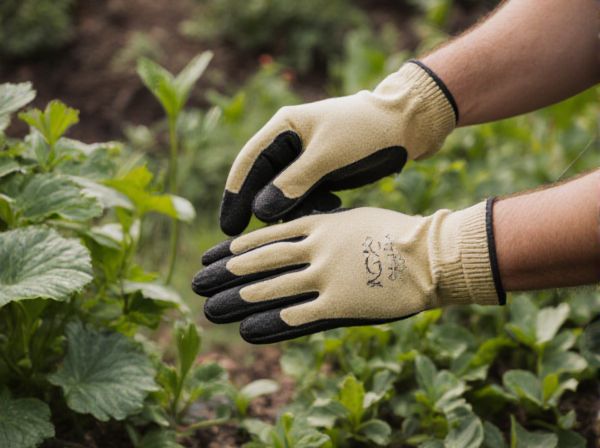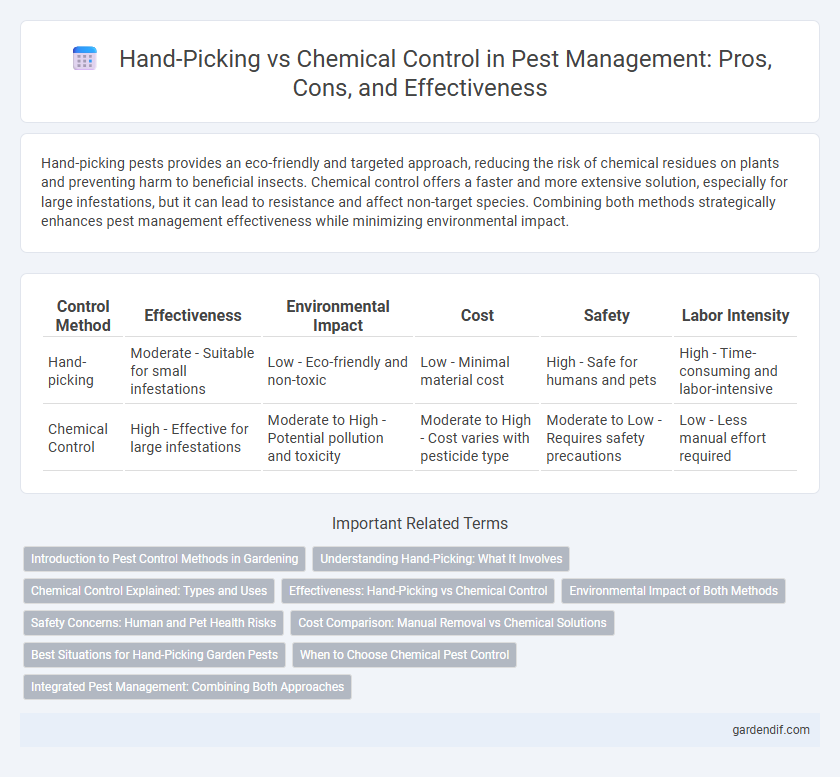
Hand-picking vs chemical control Illustration
Hand-picking pests provides an eco-friendly and targeted approach, reducing the risk of chemical residues on plants and preventing harm to beneficial insects. Chemical control offers a faster and more extensive solution, especially for large infestations, but it can lead to resistance and affect non-target species. Combining both methods strategically enhances pest management effectiveness while minimizing environmental impact.
Table of Comparison
| Control Method | Effectiveness | Environmental Impact | Cost | Safety | Labor Intensity |
|---|---|---|---|---|---|
| Hand-picking | Moderate - Suitable for small infestations | Low - Eco-friendly and non-toxic | Low - Minimal material cost | High - Safe for humans and pets | High - Time-consuming and labor-intensive |
| Chemical Control | High - Effective for large infestations | Moderate to High - Potential pollution and toxicity | Moderate to High - Cost varies with pesticide type | Moderate to Low - Requires safety precautions | Low - Less manual effort required |
Introduction to Pest Control Methods in Gardening
Hand-picking is an eco-friendly pest control method that involves manually removing insects and larvae from plants, reducing chemical dependency and preserving beneficial organisms. Chemical control uses targeted pesticides to eliminate pests rapidly but may risk harming non-target species and causing resistance over time. Integrating both methods in pest control strategies enhances effectiveness while minimizing environmental impact in gardening.
Understanding Hand-Picking: What It Involves
Hand-picking involves manually removing pests such as caterpillars, beetles, and aphids from plants, offering a targeted and environmentally friendly pest control method. This technique requires careful inspection of plants and is most effective in small gardens or early infestations to prevent widespread damage. Hand-picking reduces reliance on chemical pesticides, preserving beneficial insect populations and minimizing chemical residues in the environment.
Chemical Control Explained: Types and Uses
Chemical control involves the use of pesticides such as insecticides, herbicides, and fungicides to manage pest populations effectively. Common types include systemic chemicals that penetrate plant tissues and contact pesticides that kill pests upon direct exposure. These methods offer rapid pest eradication but require careful application to minimize environmental impact and prevent resistance development.
Effectiveness: Hand-Picking vs Chemical Control
Hand-picking pests offers targeted effectiveness by manually removing insects, minimizing damage to beneficial species and reducing chemical residues. Chemical control provides broader spectrum pest eradication with rapid results but may lead to resistance and environmental concerns. The choice depends on pest severity, crop type, and sustainability goals, balancing immediate impact against long-term ecological effects.
Environmental Impact of Both Methods
Hand-picking pests controls infestations without introducing harmful chemicals, preserving soil health and beneficial insects. Chemical control often leads to pesticide runoff, contaminating water sources and disrupting ecosystems. Choosing hand-picking reduces environmental pollution and supports sustainable pest management practices.
Safety Concerns: Human and Pet Health Risks
Hand-picking pests offers a safer alternative for human and pet health by eliminating exposure to toxic chemicals commonly found in pesticides. Chemical control methods can pose significant risks, including skin irritation, respiratory problems, and accidental poisoning, especially in households with children or pets. Choosing manual pest removal reduces these health hazards, promoting a safer environment for families and pets.
Cost Comparison: Manual Removal vs Chemical Solutions
Hand-picking pests incurs minimal direct costs, primarily labor expenses, making it cost-effective for small-scale infestations and organic practices. Chemical control involves purchasing pesticides and equipment, with higher upfront and recurrent costs but often faster results for large-scale or severe infestations. Evaluating cost-effectiveness depends on infestation severity, labor availability, and long-term pest management goals.
Best Situations for Hand-Picking Garden Pests
Hand-picking garden pests is most effective in small-scale gardens with low pest populations such as aphids, caterpillars, and beetles. This method is ideal for organic gardening where chemical use is restricted or undesirable, allowing for targeted removal without harming beneficial insects or the environment. Gardens with easily accessible plants and visible pests benefit significantly from the precision and immediacy of hand-picking compared to broad-spectrum chemical controls.
When to Choose Chemical Pest Control
Chemical pest control is most effective when infestations are widespread or rapidly increasing, making hand-picking impractical for large-scale damage mitigation. Select synthetic insecticides or fumigants specifically labeled for the target pest to ensure optimal efficacy and minimize environmental impact. Timing applications during vulnerable pest life stages, such as larval or early nymph phases, maximizes control success and reduces the likelihood of resistance development.
Integrated Pest Management: Combining Both Approaches
Hand-picking pests provides an eco-friendly, targeted method for pest control, reducing chemical residues and protecting beneficial insects. Chemical control offers rapid and broad-spectrum pest suppression, essential for severe infestations or hard-to-reach areas. Integrated Pest Management (IPM) combines these strategies, optimizing pest control efficacy while minimizing environmental impact and promoting sustainable agricultural practices.
Hand-picking vs chemical control Infographic

 gardendif.com
gardendif.com